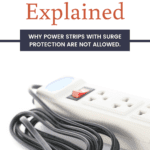At some point in your cruise planning, you have likely heard that surge protectors are not allowed on cruise ships. So, while you will benefit from having a travel power strip in your cabin, you must take care to select one that does not have surge protection.
Wondering why “no surge protector on cruise ship” is a rule? It’s a matter of shipboard safety. Because of the differences in electricity configuration between land and sea, surge protectors carry an increased fire risk. And, fire on a ship at sea can be particularly perilous!
Keep reading to learn more about why all cruise lines have some version of this rule, and why you should take it seriously.
- Regular surge protectors can disrupt a cruise ship’s electrical balance by blocking only one of the two active currents in the ship’s outlets. Unlike in homes, both wires in a cruise ship’s outlets are “live,” and this partial blockage can cause overheating and fires.
- The US Coast Guard has documented ship-board fires caused by surge protectors which resulted in a warning against using surge protectors on sea vessels.
- Travelers should use non-surge-protected power strips or other alternatives to expand outlet availability in their cabins safely.
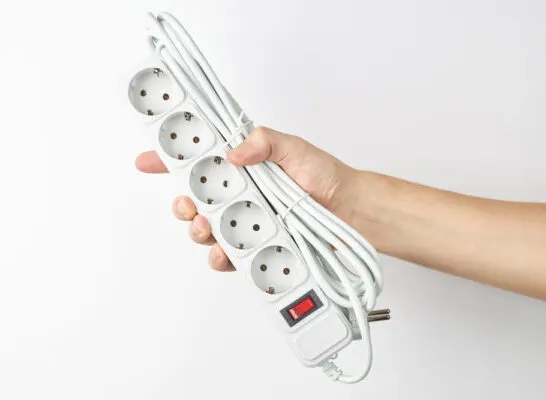
Why Surge Protectors Are Banned From Cruise Ships
Here is the short answer: The electrical circuits in a house and a cruise ship are very different.
Surge protectors are not allowed on cruise ships because they increase fire risk. The reason this danger exists is that a normal surge protector only breaks the circuit on the “live” electrical wire, whereas both the “live” and “neutral” wires carry current on a cruise ship.
The Electrical Circuit In A House
This is the high-level basic version of how electricity generally works.
We are all familiar with electrical outlets – the items on the wall or floor that allow electrical devices to connect to the electrical grid and receive power. The two sides of an electrical outlet essentially form parts of a loop, and when you plug a device into the outlet, it completes the loop.
Of the slots in an outlet, one will be “hot,” and one will be “neutral.” If there is a third slot, it will be for “grounding.” Thus, for either two-prong or three-prong outlets – only one wire will be hot.
How Electricity Flows in a Circuit
In the outlets in your home, power flows from hot to neutral. The device you plug into an outlet completes the circuit between the hot slot and the neutral slot. Electricity flows through the device and powers whatever the intended operation should be.
A surge protector is designed to interrupt the flow of electricity when it detects an excessive charge that may overwhelm the system.
The live wire delivers 120V (North America), and the neutral wire completes the circuit. The ground circuit is connected to the main breaker panel.
Only one prong out of the three carries a live current.
The typical surge protection device made for home use will interrupt only the hot conductor when a surge occurs.
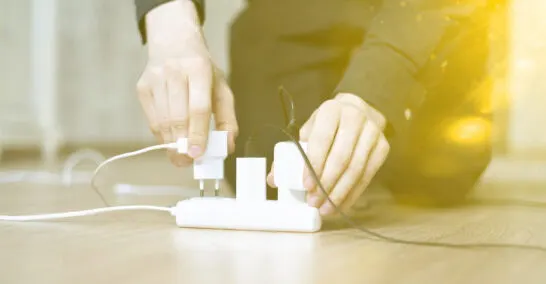
The Electrical System On A Cruise Ship
A ship’s wiring is different.
Unlike land-based systems, where the neutral wire is typically grounded on a cruise ship, the neutral is isolated from the ship’s hull. This setup enhances safety by preventing ground faults, which could create a direct path for current that might lead to electric shocks or fires.
In this ungrounded system, all conductive paths can potentially carry current; thus, both wires in a circuit can be considered ‘live’ in terms of shock risk.
This means that, unlike typical residential systems where only the ‘hot’ wire would pose a shock hazard, on a cruise ship, contact with any wire while also contacting the ship’s structure (which acts as the ground) could result in an electric shock.
The voltage levels on a cruise ship are typically standardized, similar to those on land (often 120V or 220V), but the key difference is the lack of a ground connection to earth. This setup requires careful monitoring and the use of advanced safety systems, such as ground fault indicators and circuit protection technologies, to ensure that any electrical faults are quickly detected and remedied to maintain safety aboard.
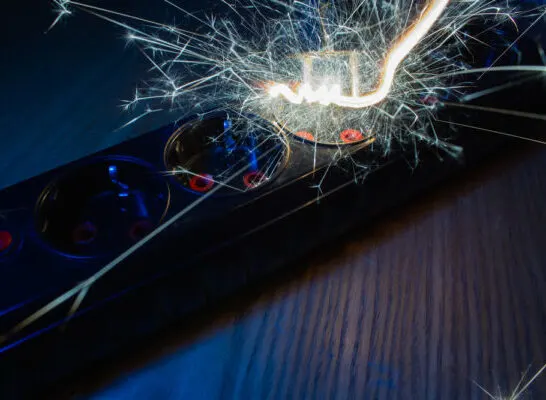
Why No Surge Protector On Cruise Ship: The US Coast Guard 2013 Warning
The notice, which was issued to vessel owners, advised that following the completion of two separate fires on container vessels, they concluded that the immediate cause was surge protector devices that failed.
A marine casualty investigation of two separate stateroom fires onboard a US-flagged container ship attributed the sources of the fires to the use of surge protective devices plugged into a lighting circuit.
The US Coast Guard concluded that even though the live circuit had tripped, current continued to be supplied through the “neutral” circuit and shorted the device’s ground wire to the vessel’s structure.
The Coast Guard advised that surge protector devices used on cruise ships must be able to break both power conductors.
Adding More Power Outlets to Your Cruise Cabin Safely
Surge-protected power strips are not allowed on cruise ships because they’re not safe. So, if you need more outlets for charging all your devices, especially when sharing a room, here’s what you can do:
- Use a power strip that doesn’t have surge protection.
- Pack something else that works like a power strip but is safe for cruises, like an outlet extender.
Selecting Non-Surge Power Strips for Cruises
The first option is simple: Look for a travel power strip that lacks surge protection. You can find these at most stores or online. Just make sure the product clearly says it has no surge protection. While some might be labeled as “cruise-approved,” that’s mostly for marketing. The key is the absence of surge protection, not the “cruise-approved” label.
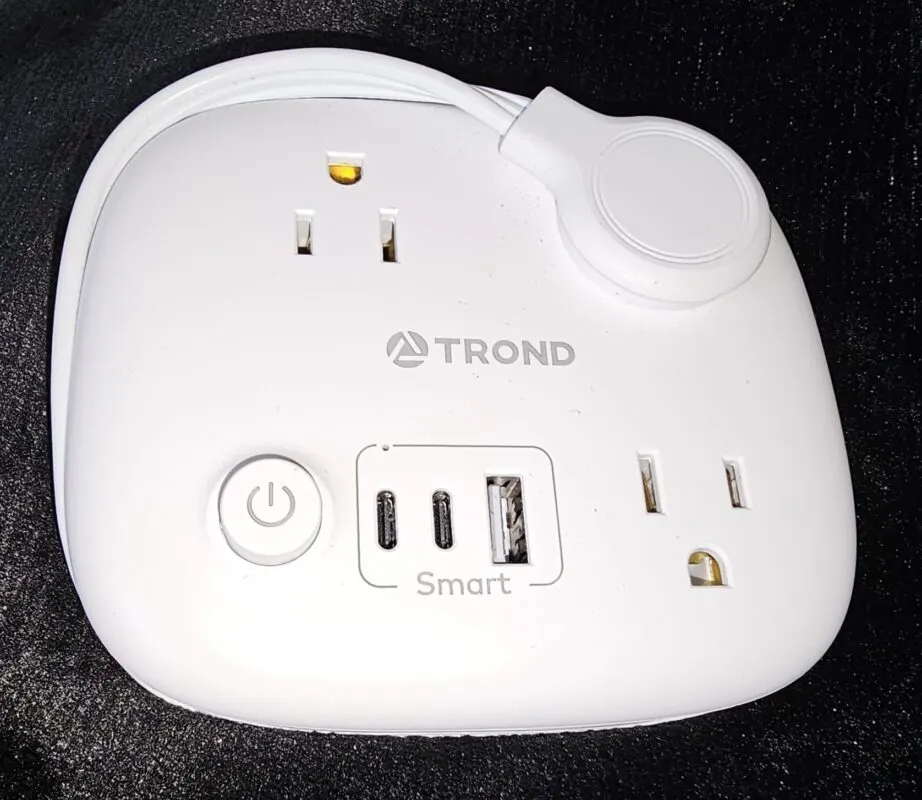

A non-surge power strip will give you enough outlets to charge devices like smartphones and cameras for everyone traveling with you.
Safe Alternatives to Power Strips for Your Cruise
Besides regular power strips, there are other ways to get more power in your cruise cabin. We’re sharing a few alternatives that suit various needs, helping you find what’s right for you. Plus, we’ll mention our top picks for 2024.
Outlet Extenders
These are simple tools that turn one outlet into several, making them perfect for travel. They’re small and light, fitting easily in your luggage. Useful in hotels, airports, and on cruises, they help charge multiple devices like phones, laptops, and cameras from one spot. Many come with USB and USB-C ports, letting you charge directly and skip carrying extra chargers.
USB Hub Stations
A USB hub station lets you charge multiple USB-powered devices at once, without needing a wall outlet. They’re great for phones, tablets, cameras, and some laptops. Look for hubs with several USB ports, including USB-C for the latest gadgets.
Portable Power Banks
High-capacity power banks mean you can charge your devices anytime, anywhere. If you pack extra power banks, you can leave spare ones charging up during the day, then use them to power your phone, tablet, or e-reader overnight. This works well if you have power banks that can charge multiple devices at the same time.
Of course, you can also use power banks while you’re out and about. They’re a traveler’s best friend, ensuring you’re never left with a dead battery.
Battery-Powered or USB-Rechargeable Gadgets
Choosing gadgets that run on batteries or can be charged via USB cuts down your need for outlet space. From fans and nightlights to speakers, these items can be powered up using a USB hub or charger. It’s a smart move to stay fully charged and comfortable, wherever you are.
This post contains affiliate links that could result in a commission to this website (at no additional cost to you). Visit our Disclosures Page for more information.
Our Personal Favorite Cruise-Safe Power Choices (2024)
These are the travel devices that we have taken on our most recent cruises. They have performed well and earned an esteemed place in our travel luggage. Tip: Pack least one in a carry-on bag so that you can easily whip it out in an airport or on a plane as needed.
The Trond Flat-Plug Power Strip
- 【Flat Plug Saving Space】With only a 0.33-inch ultra flat plug design, the upgraded flat wall plug is thinner than the regular flat plugs, which can easily fit in tight spots and hide behind the furniture, sitting flush against the wall completely. The wrapped-around cord is much thinner than the standard round power cord to run smoothly under…
- 【USB Power Strip】This USB power strip features 3 widely spaced outlets and adds 2 USB C and 1 USB A, which provide power and charging for up to 6 devices. Max. power: 1250W (125V-10A). AC 100-250V. Maximum 3A output for each USB C port and Maximum 2.4A output for USB A port, USB total output 3.4A/17W. Power Delivery charge technology for USB C…
We loved this power strip when it first came out. Check out our detailed first-hand review. And it has become our go-to travel power strip.
Our favorite features:
- The truly compact design. It has a recessed groove so that the wrap-around cord can stay flush with the device and not bulk up.
- The widely spaced outlets so that they can be used simultaneously.
- The flat plug that plugs into its own outlet for tidy storage.
The Anker 3 Port USB Fast Charger (Compact Version)
- 3-in-1: Equipped with two USB-C ports and one USB-A port to power three devices simultaneously.
- High-Speed USB-C Charging: Loaded with 67W of power to charge phones, tablets, and laptops. Fast charge a MacBook Pro 13″ (M1) from 0 to 50% in just 46 minutes.
- Compact and Foldable: Slightly smaller than an original 67W charger and equipped with a foldable plug that makes it easy to carry.
This USB hub station from Anker is great for travel. Anker has multiple versions of hub stations, including multiple versions of 67W USB hub stations. This version is a smaller compact size with a foldable plug, and it definitely delivers on the speed.
Our favorite features:
- Top line fast-charging capabilities
- Comes with its own 5-foot cord
- Foldable plug makes it easy to pack (or slip in a pocket)
- Wide compatibility with both Apple and Samsung devices
Frequently Asked Questions
Can I bring any type of power strip on a cruise?
No. Not all power strips are suitable for cruise ships. Only bring a power strip that does not have surge protection.
What happens if I accidentally bring a surge protector on a cruise?
If you bring a surge protector onboard, it’s likely that the cruise ship’s security measures during the embarkation process will confiscate it. If not spotted at that time, it may be confiscated later if noticed by your state room attendant. This is to adhere to the ship’s safety protocols and prevent any potential fire hazards.
How can I identify a safe power strip for cruise ship use?

Look for power strips explicitly labeled as “without surge protection,” “no surge protection,” or “cruise-approved.” These products are designed to be compatible with cruise ship electrical systems and are safe to use.
Do all cruise lines, such as Royal Caribbean and Carnival, have the same policies regarding power strips without surge protectors?
While you will commonly find a ban on surge protectors across all major cruise lines for safety reasons, specific policies may vary slightly. Check with your individual cruise line before embarking to confirm their approved types of power strips and electrical devices. You can usually find this information on the cruise line website.
Conclusion
While surge protectors increase safety on land, they can increase the danger of fire on a cruise ship. You can readily find power strips and outlet expanders without the problematic feature, and you should take steps to do so. Stay safe!
Keep up with the latest cruise tips and insights! Follow us on Pinterest:
Last update on 2024-07-26 / Affiliate links / Images from Amazon Product Advertising API

